Security Problem Forecast for Blockchain Technologies in 2024
Blockchain technology is expanding and gaining strategic importance every year, impacting various industries, from financial institutions to healthcare. The total assets in the blockchain world amount to over $1.2 trillion. This sum is comparable to the annual gross domestic product of a country like Spain. The overall long-term trend for this value is on the rise, despite seasonal fluctuations and downturns. In light of this, maintaining preventive measures becomes more of a priority than ever before.
Like almost any other innovation, blockchain is associated with its unique set of vulnerabilities and security threats. Therefore, drawing from our experience, we look to the future to identify and understand the key risks that developers, owners, and users of blockchain-based products and services are likely to face.
In this article, we will provide examples of the major security threats that, in our opinion, will be relevant to blockchain technology in 2024, and discuss strategic approaches and recommendations capable of ensuring robust protection for this technology, essential for the development of modern society and the economy.
Incidents in the Blockchain World

Let’s take a look at the overall picture of incidents related to blockchain, including cryptocurrency crimes, to better understand the strategies and security measures to be used in the future.
We have analyzed SlowMist’s report on blockchain security and anti-money laundering (AML), the Chainalysis report on crypto crime, as well as a range of other analytical and statistical reports.
In the first half of this year, there were 185 major security incidents in the blockchain, resulting in losses of up to $920 million. At the same time, this figure is 54% lower compared to the first half of 2022 when losses amounted to around $2 billion.
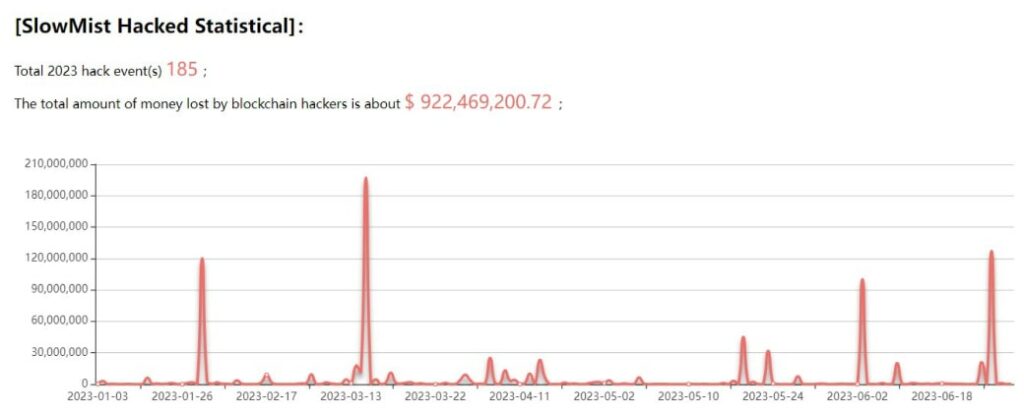
The DeFi, NFT, and Cross-chain Bridge sectors suffered the most significant losses – 131 incidents and losses totaling around $487 million. Despite fewer incidents in trading platforms, public networks, and crypto wallets, they also incurred substantial financial losses.
Crypto mixing platforms, such as Tornado Cash and eXch, have become the focal point of increased user attention and are widely used for questionable transactions.
Phishing scams carried out by groups such as Pink Drainer, Vemon Drainer, Monkey Drainer, Pussy Drainer, and Inferno Drainer continue to pose a serious threat to the blockchain community.
Ransomware attacks are actively evolving. Wrongdoers managed to extort nearly $450 million, which is more than one and a half times higher than the previous year. This growth indicates more aggressive tactics and ambitious goals of criminals.
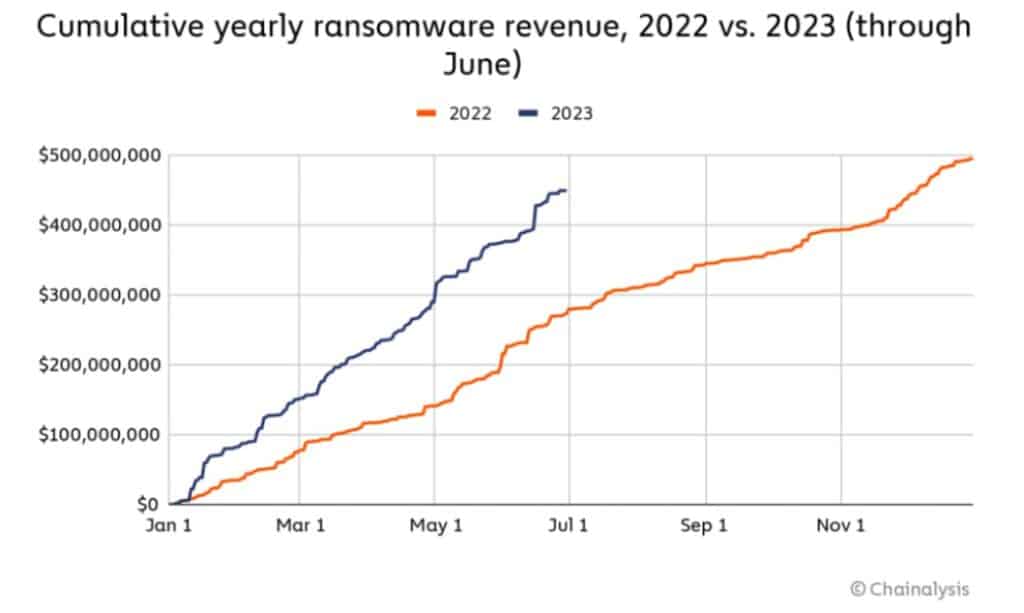
Fraud and hacks remain among the most profitable forms of cryptocurrency crime.
Damages in fake identity fraud schemes have increased by almost 50% compared to the previous year. Swindlers posing as government officials continue to take significant amounts of money from their victims.
An important feature of the current threat landscape is the growing geopolitical motives behind cryptocurrency crime. Groups from North Korea continue to serve as an incubator for hacking activities and remain one of the largest active threats in the cybercrime landscape.
Hacker groups associated with North Korea are increasingly using Russian exchanges known for laundering illegal crypto assets. This year, the volume of stolen cryptocurrencies linked to North Korean hacker groups, such as the Lazarus Group, exceeded $340 million.
North Korean groups accounted for almost 30% of all cryptocurrencies stolen in hacking attacks this year. Despite the decrease in numbers, Chainalysis analysts caution that this does not necessarily indicate an overall improvement in cryptocurrency security or a reduction in cybercrime.
In the second half of this year, the number of cryptocurrency hacks increased by almost 60% compared to the same period last year. As a result of these incidents, nearly $686 million was lost. An incident of particular significance was the hack of Mixin, which occurred on September 25, 2023, during which the perpetrators made off with approximately $200 million.
In ten incidents in the first half of 2023, stolen funds were successfully recovered. Out of the stolen $232 million, an impressive sum of $219 million was returned. This trend underscores the importance of robust security strategies, collaboration in incident investigations, effective negotiations, and rewards.
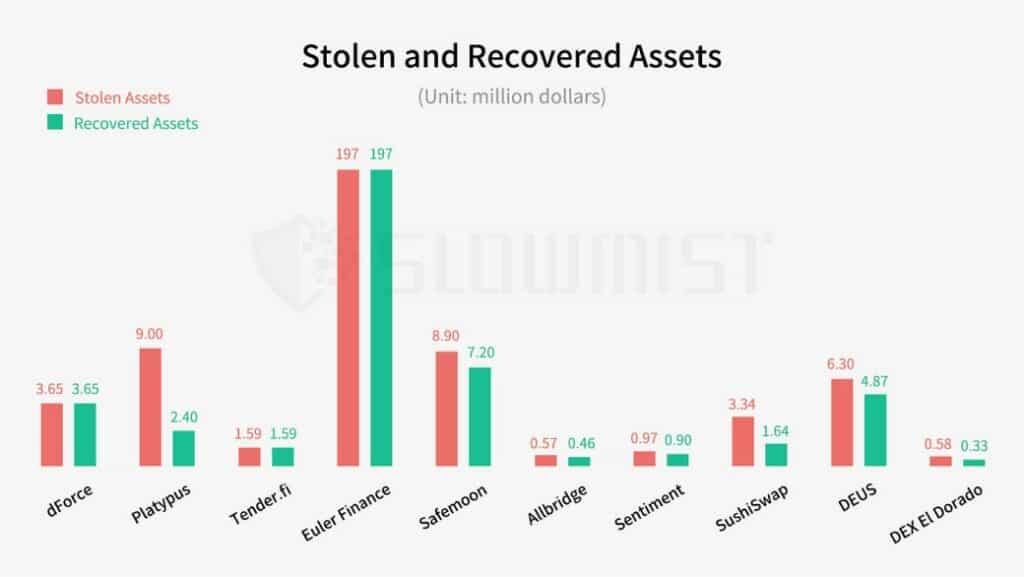
Chainalysis analysts also highlight local positive changes in cryptocurrency transactions. In mid-2023, there was a 65% decrease in the volume of illicit transactions compared to the previous year.
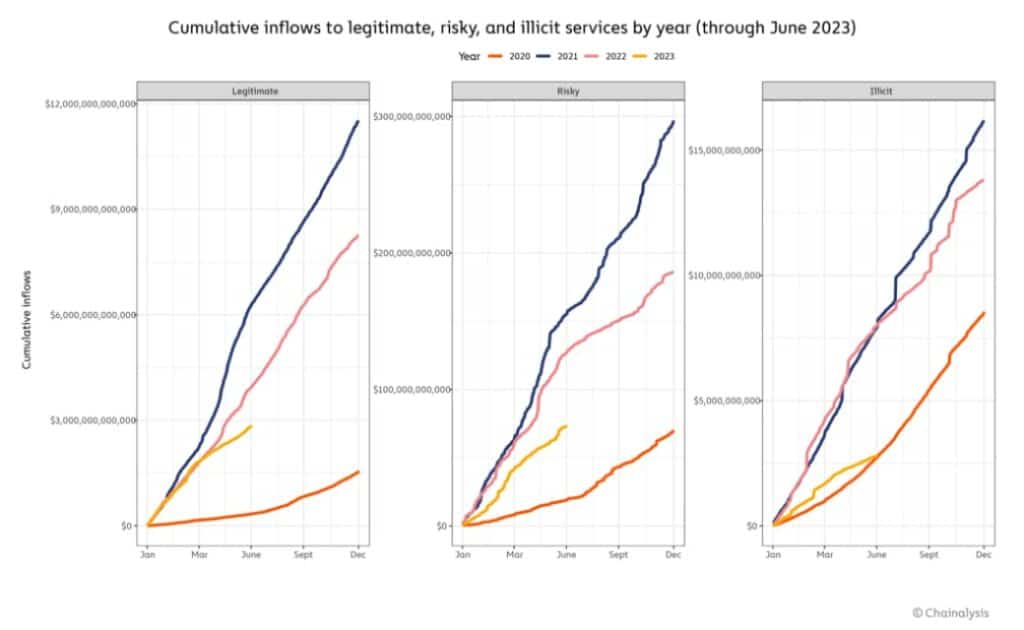
Despite a temporary decrease in cryptocurrency crime activity due to seasonal fluctuations in blockchain activity and heightened security measures, the overall trend of security incidents continues to rise. The evolution of the blockchain ecosystem each year brings forth new challenges, prompting us to take security matters even more seriously.
Blockchain Cybersecurity Issues in 2024: A Look into the Future of Technology and Threats to It

Despite local reductions in the number of cryptocurrency and blockchain project hacks in 2023, serious concerns about the security of the blockchain ecosystem persist.
In our opinion, the decrease in security incident losses in the blockchain is temporary and tied to the overall reduced blockchain activity during the crypto winter – the “bear” market season. At the same time, it’s evident that with the promising launch of Bitcoin ETFs, the rise in cryptocurrency and token prices, and the revival of blockchain projects’ activity, and their transactions, security incident losses will increase.
Ransomware attacks are on the rise, with major DeFi projects falling victim. Fraud and hacks are also causing concerns. Blockchain remains an attractive target for malicious actors, and there is still a need for enhanced security measures to protect the blockchain ecosystem.
After analyzing numerous incidents and trends, we share our thoughts on the most relevant threats blockchain is likely to face in 2024.
One of the most significant threats is the increase in attacks on smart contracts. With the growing number of smart contracts integrated into the blockchain, there is an expectation of increased attacks on their vulnerabilities and code errors. This could lead to financial losses and a loss of trust in the technology.
A serious threat to consider is social engineering. Wrongdoers are becoming increasingly sophisticated in their use of psychological manipulation to gain access to private keys and, consequently, steal cryptocurrencies and confidential data. Strengthening user education and awareness of risks and protection methods is necessary.
Another important threat is the activity of state actors aimed at asset theft, disruption, excessive regulation, or monitoring of blockchain networks. The growing interest of governments, and radical, and terrorist organizations in blockchain may lead to new types of risks and challenges in the face of geopolitical instability, approaching the beginning of a third world war.
Considering these threats, as well as those related to the development of quantum computing, privacy deficiencies, the use of zero-day vulnerabilities, and fraud in the ICO and DeFi sectors, blockchain cybersecurity in 2024 requires constant attention and comprehensive innovative solutions.
How to Reduce Risks and Protect Blockchain in 2024
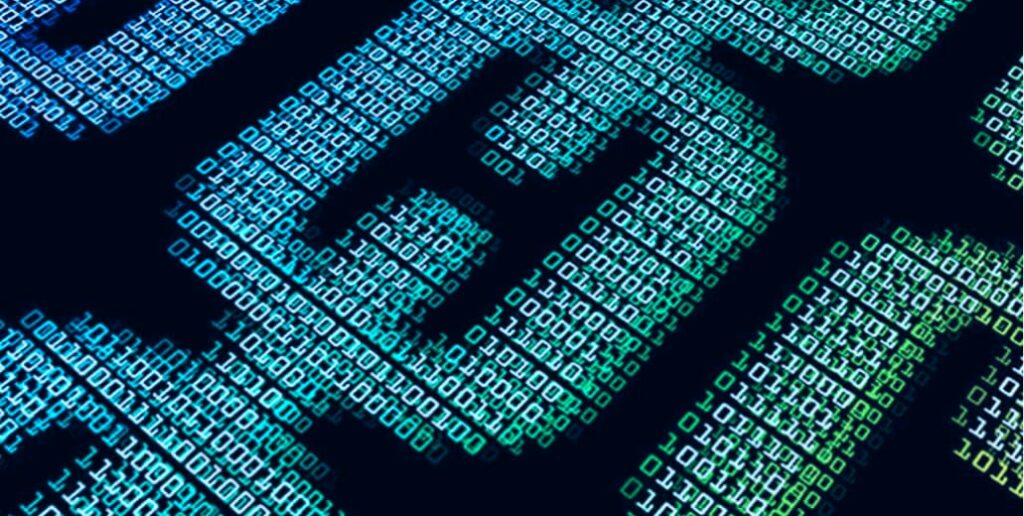
To reduce risks and ensure reliable protection of blockchain technology in 2024, we are convinced of the need for the systematic implementation of advanced cybersecurity practices:
1. Enhancing Smart Contract Security: effective analysis and monitoring of smart contracts should become a priority for developers and participants in blockchain networks. Regular audits and code analysis will help identify vulnerabilities before malicious actors can exploit them. Such a focus on code security will not only save resources but also bolster user trust in the technology.
2. User Education and Awareness: educating end-users of cryptocurrency services and blockchain network participants on methods to protect their private keys, other security rules, social engineering detection, and other risks plays a crucial role. Regular training programs, webinars, informational materials, and intelligent contextual prompts in cryptocurrency applications will help raise awareness levels and enhance user security.
3. Improving Network Security: protecting blockchain technology infrastructure from external attacks becomes more crucial as blockchain continues to grow. The implementation of modern network security methods, including device authentication and anomaly monitoring, will provide additional layers of protection against attacks.
4. Collaboration and Information Sharing: active collaboration and information exchange within the blockchain community will enable timely and effective threat detection, counteraction, incident investigation, and damage reduction. The collective effort of all participants contributes to the overall strengthening of cybersecurity.
5. Research and Development of Quantum-Resistant Encryption: the development of quantum-resistant encryption methods is a promising task. This will protect data and transactions from potential attacks using quantum computing. While such attacks are mainly theoretical at this point, the risk of their practical realization grows steadily each year.
6. Enhancing Privacy and Confidentiality: developing and implementing solutions that enhance data anonymity and confidentiality in the blockchain will help reduce the risks of data leaks and breaches of privacy. We believe that privacy is inherent in blockchain technology from its inception. Therefore, government regulation and the development of Know Your Customer (KYC) approaches, which should also be applied, should not hinder the development of privacy that is organically intrinsic to blockchain.
7. Updates and Patches: we recommend that blockchain developers strengthen their software update and patch policy. Software working with crypto assets should prohibit users from using outdated vulnerable versions until they are updated. This will allow for the prompt elimination of discovered vulnerabilities and the maintenance of blockchain security.
Thanks to these measures, blockchain will maintain its image as an advanced and reliable technology ready to overcome future challenges. At the same time, organizations operating in the blockchain sector will strengthen their positions in the rapidly changing digital environment, ensuring the security and reliability of their operations.
Contact us to discuss your vision of top security measures in the industry or the initial steps toward strengthening the security of your specific project.
_______________________________
Subscribe to our Telegram channel to make sure you do not miss any new articles on our blog.
